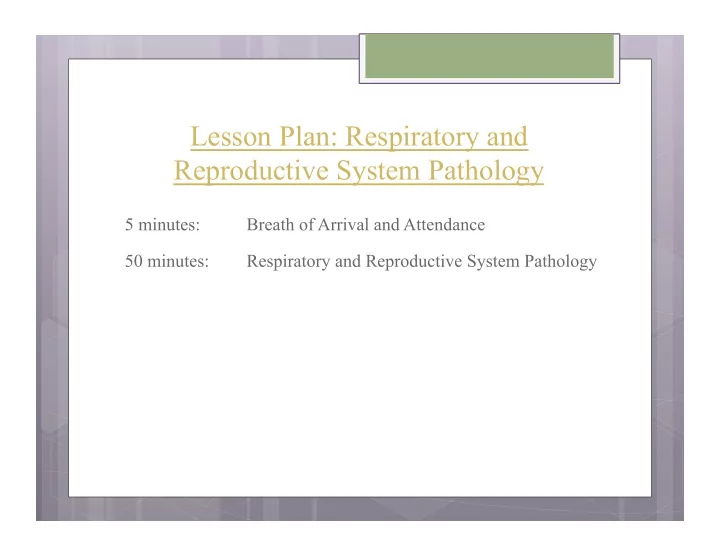

Lesson Plan: Respiratory and Reproductive System Pathology 5 minutes: Breath of Arrival and Attendance 50 minutes: Respiratory and Reproductive System Pathology
Classroom Rules Punctuality- everybody's time is precious: Be ready to learn by 9:00, we'll have you out of here by 1:30 Tardiness: arriving late, late return after breaks, leaving early The following are not allowed: Bare feet Side talking Lying down Inappropriate clothing Food or drink except water Phones in classrooms, clinic or bathrooms You will receive one verbal warning, then you'll have to leave the room.
Respiratory and Reproductive System Pathology
Respiratory System Pathology (Werner Page 321) Infectious Respiratory Chronic Obstructive Disorders Pulmonary Disease Acute bronchitis Asthma Common cold Cystic fibrosis Influenza Laryngeal cancer Pneumonia Lung cancer Sinusitis Tuberculosis
Reproductive System Pathology (Werner Page 445) Disorders of Other Female Disorders of the Uterus Reproductive Structures Cervical cancer Breast cancer Dysmenorrhea Ovarian cancer Endometriosis Ovarian cysts Fibroid tumors Uterine cancer
Reproductive System Pathology (Werner Page 445) Other Reproductive System Disorders of the Male Reproductive System Conditions Benign prostatic Menopause hyperplasia Pregnancy Prostate cancer Premenstrual syndrome Prostatitis Sexually transmitted Testicular cancer diseases
Respiratory System Pathology Common cold Viral infection of the respiratory tract. Nasal discharge, sore throat, mild fever, dry coughing, and headache. Risks Easily contagious. Take precautions against transmission Massage may exacerbate symptoms Benefits Gentle, reflexive or energetic work can be helpful if a person is having trouble moving past the peak of a cold. Massage in the sub-acute stage may help speed recovery, although symptoms may be temporarily exacerbated
Respiratory System Pathology Pneumonia Inflammation of the lungs due to infection.
Respiratory System Pathology Pneumonia Inflammation of the lungs due to infection. Risks Contagious Difficulty adapting to rigorous massage Benefits During recovery percussive tapotement aids with expulsion of mucus from the lungs, and gentle massage promotes relaxation and sleep
Respiratory System Pathology Sinusitis Inflammation of the paranasal sinuses from infection, allergies, or physical obstruction.
Respiratory System Pathology Sinusitis Inflammation of the paranasal sinuses from infection, allergies, or physical obstruction. Risks Absolute contraindication if due to infection Lying down, especially face down, may be uncomfortable Benefits Very gentle massage around the face may help the sinuses to drain
Respiratory System Pathology Chronic bronchitis Long-term inflammation of the bronchi.
Respiratory System Pathology Chronic bronchitis Long-term inflammation of the bronchi. Risks Risk of respiratory infections. Rigorous massage contraindicated. May lead to heart failure Benefits If the heart is healthy and no acute infection is present, massage can bring comfort Focused work on breathing muscles may ease breathing
Respiratory System Pathology Asthma Chronic airway inflammation and intermittent airflow obstruction
Respiratory System Pathology Asthma Chronic airway inflammation and intermittent airflow obstruction. Risks Contraindicated during acute attacks Scents, candles, and essential oils may exacerbate symptoms Use hypoallergenic lotion Benefits During sub-acute stages, include massage of diaphragm, intercostals, and scalenes
Reproductive System Pathology Dysmenorrhea Menstrual pain that is severe enough to limit the activities of women of child-bearing age. Risks Avoid intrusive abdominal massage Benefits Very helpful for coping with pain
Reproductive System Pathology Menopause The moment when ovaries no longer respond to chemical signals to establish a reproductive cycle. Risks None Benefits Helps cope with changes in self-identity and physical processes
Reproductive System Pathology Pregnancy The state of carrying a fetus.
Reproductive System Pathology Pregnancy The state of carrying a fetus. Risks Varies by trimester Benefits Adaptations made for each trimester Helps with fatigue, muscle and joint pain, and clumsiness
Reproductive System Pathology Premenstrual syndrome Collection of many signs and symptoms that occur in the time between ovulation and menstruation. Risks None Benefits Offers support for a negative physical experience that is predictable, debilitating, and frustrating.
Reproductive System Pathology Sexually transmitted infections Contagious conditions that are spread through intimate contact. Risks Refer to specific infections Benefits If the infection has been identified and controlled, massage within the client’s capacity for adaptation is appropriate
Respiratory and Reproductive System Pathology
Recommend
More recommend